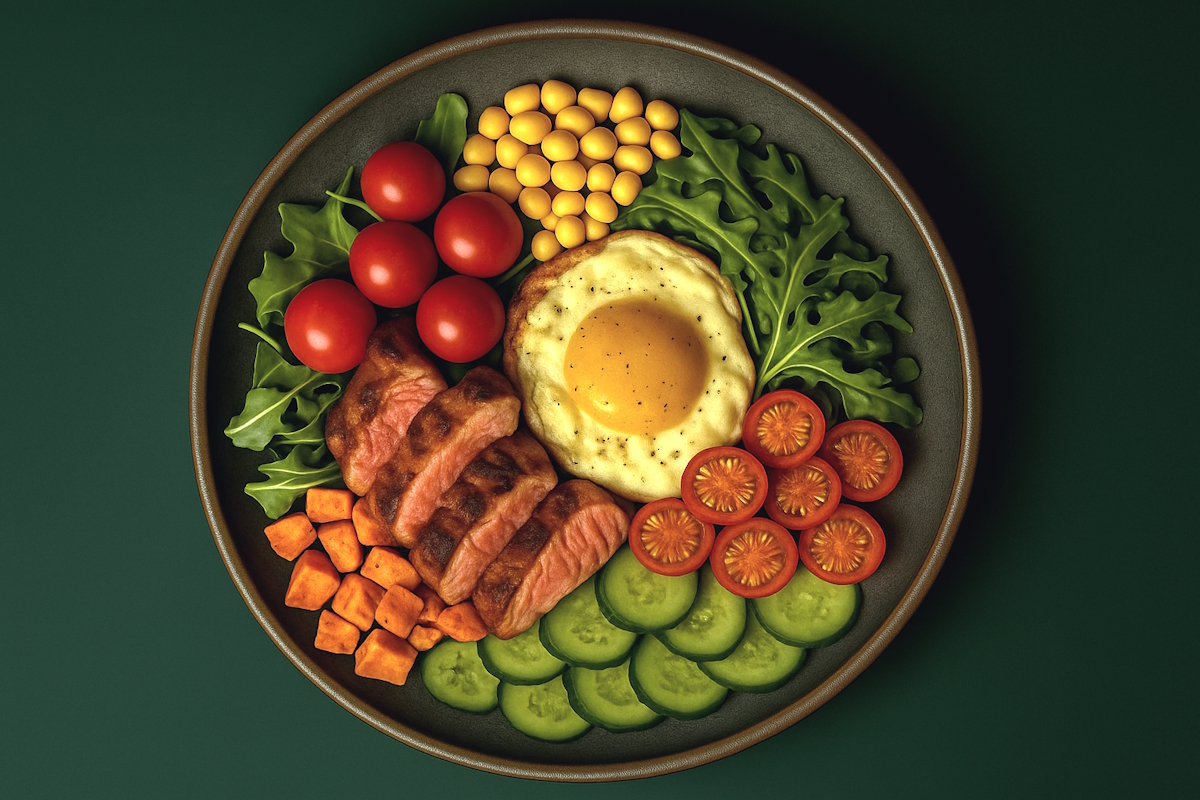From the Brickyard | Subject: Fueling the Musclebuilder
——
You want a body that turns heads—and doesn’t break down under pressure. One that performs like a weapon and looks like it was chiseled from stone.
That’s the goal, right?
Then you need a plan that fuels growth without feeding fat.
Here’s how to eat like a Musclebuilder—muscular, lean, and dialed in.
The Musclebuilder Eating Code
Your body’s a fortress. Here’s how to fuel the build:
- Lay the Bricks (get your protein)
- Fuel the Fire (utilize a sensible calorie surplus)
- Cut the Fluff (chisel up occasionally)
- Use Fiber as a Weapon (eat your fibrous carbs)
- Dominate with Whole Foods (eat more lower-ingredient foods)
- Occasionally Flex (indulge in a controlled way)
1. Lay the Bricks: Get Your Protein—Every Damn Day
Protein isn’t optional. It’s the brick and mortar of muscle.
Aim for 0.8–1g of protein per pound of bodyweight daily—and don’t dump it all in one meal. Studies suggest muscle protein synthesis peaks around 0.4g per kg per meal (~30g for most men), so spread your intake over 3–5 meals throughout the day (Jäger et al., 2017).
- Animal sources: beef, eggs, fish, poultry, dairy (milk, Greek yogurt, cottage cheese).
- Vegetarian sources: peas, beans, lentils, whole grains.
- Protein powders and bars can help if you’re not hitting your numbers.
2. Fuel the Fire: Eat Enough—But Don’t Overflow
Muscle needs fuel. But not too much fuel. This is musclebuilding, not fatbuilding.
Research confirms this—a mild surplus (250–500 calories) is ideal. Without it, gaining serious muscle is tough. But push it too far and you’ll just pack on fat (Murphy & Koehler, 2021).
After protein, here’s how to stack your macros:
- Fat: Needed for hormones and other important processes. Go for whole milk, eggs, beef, nuts, fish rich in omega-3s.
- Carbs: You train hard. You need fuel. Think rice, oats, fruits, and veggies.
Keep it sensible and build without ballooning.
3. Cut the Fluff: Chisel Up
You can’t live in a surplus forever. If you do, the scale keeps climbing—and not all of it will be muscle. Eventually, you’ll drift out of that prime body fat range (8–15%) where you look and feel your best.
So when you start looking fluffy, it’s time to chisel up and sharpen your physique. Drop your calories by 250–500 a day. Nothing drastic—just enough to chisel away at the fat while keeping your hard-earned muscle.
Once you’re back in that sweet spot, shift to maintenance or ease back into a surplus and keep building.
4. Use Fiber as a Weapon
Higher-fiber diets help with satiety, blood sugar regulation, and yes—they’re linked to better weight control and lower body fat (Slavin, 2005).
Indeed, fiber slows digestion = stable energy and appetite control.
It also helps your body absorb nutrients better—critical when you’re in build mode.
Shoot for 25–35g of fiber per day, ideally from whole foods like vegetables, fruit, oats, and legumes. This range aligns with recommendations from the Institute of Medicine (2005), which suggests 38g/day for men under 50 and 30g/day for men over 50.
Don’t sleep on fiber, brother. Use this powerful tool.
5. Dominate with Whole Foods—Not Factory Junk
Whole foods keep it real. You know what you’re eating—protein, carbs, fats, fiber, vitamins, minerals. They’re harder to overeat, easier to track, and they give you more muscle-building power per calorie.
Ultra-processed foods…not so much. They’re engineered for cravings, not performance.
In fact, one study found that people eating ultra-processed foods consumed about 500 more calories a day—without even realizing it (Hall et al., 2019). That’s a fast track to fat gain, not muscle.
Cut back on:
- Seed oils, sugary drinks, baked goods, fast food, frozen meals.
- Anything with more chemicals than ingredients.
Instead:
- Stick to foods your great-great-grandfather would recognize—meat, eggs, nuts, fruit, veggies, rice, oats, plain dairy.
- Build your plate from the ground—not the factory.
6. Indulge With Intention—Then Lock Back In
Yeah, I let loose now and then. You should too.
But if you’re constantly smashing pizza, burgers, ice cream, and candy forget about staying around 8–15% body fat.
Here’s the thing: discipline doesn’t mean perfection. It means control. Own your indulgences—don’t let them own you. So enjoy a break—but keep it controlled.
Enjoy it. Then lock back in.
Bottom Line
Big muscles. Low body fat. It’s not magic—It’s method. It’s discipline, intention, and execution.
Remember:
- Protein builds.
- Calories fuel.
- Fiber controls.
- Whole foods dominate.
Go as hard in the kitchen as you do in the gym.
Final Thought
This isn’t a diet. It’s a discipline. A way of life for men who build—who lead—who leave a mark.
This is how the Musclebuilder eats.
Brick by brick.
-Brickwall
Sources
Jäger, R., et al. (2017). International Society of Sports Nutrition position stand: Protein and exercise. Journal of the International Society of Sports Nutrition, 14(20). https://pubmed.ncbi.nlm.nih.gov/28642676/
Murphy, C. H., & Koehler, K. (2021). Energy deficiency impairs resistance training gains in lean mass but not strength: A meta-analysis and meta-regression. Sports Medicine, 51(5), 873–891. https://pubmed.ncbi.nlm.nih.gov/34623696/
Slavin, J. L. (2005). Dietary fiber and body weight. Nutrition, 21(3), 411–418. https://pubmed.ncbi.nlm.nih.gov/15797686/
Hall, K. D., et al. (2019). Ultra-processed diets cause excess calorie intake and weight gain: An inpatient randomized controlled trial of ad libitum food intake. Cell Metabolism, 30(1), 67–77.e3. https://pubmed.ncbi.nlm.nih.gov/31105044/
Institute of Medicine. (2005). Dietary Reference Intakes for Energy, Carbohydrate, Fiber, Fat, Fatty Acids, Cholesterol, Protein, and Amino Acids (Macronutrients). The National Academies Press. https://nap.nationalacademies.org/catalog/10490/dietary-reference-intakes-for-energy-carbohydrate-fiber-fat-fatty-acids-cholesterol-protein-and-amino-acids

